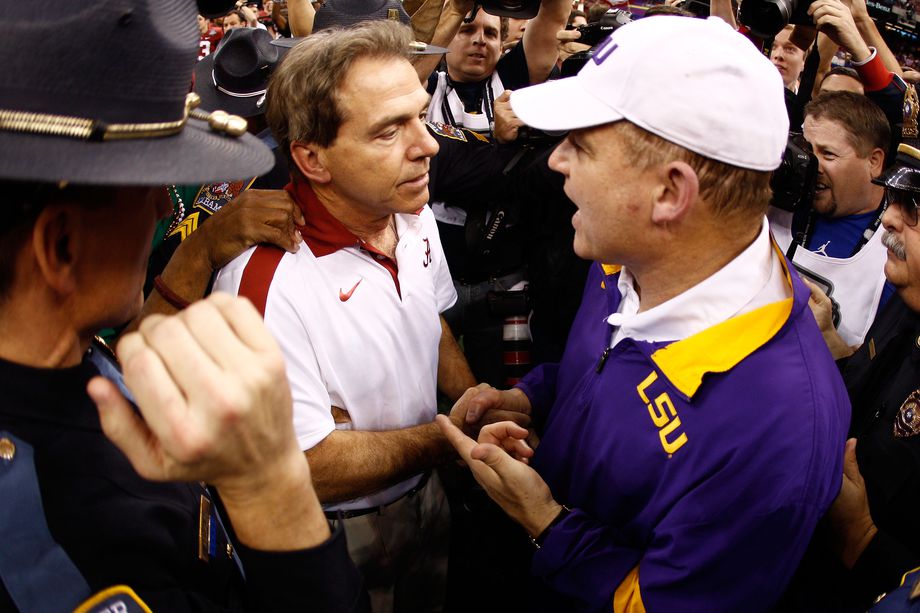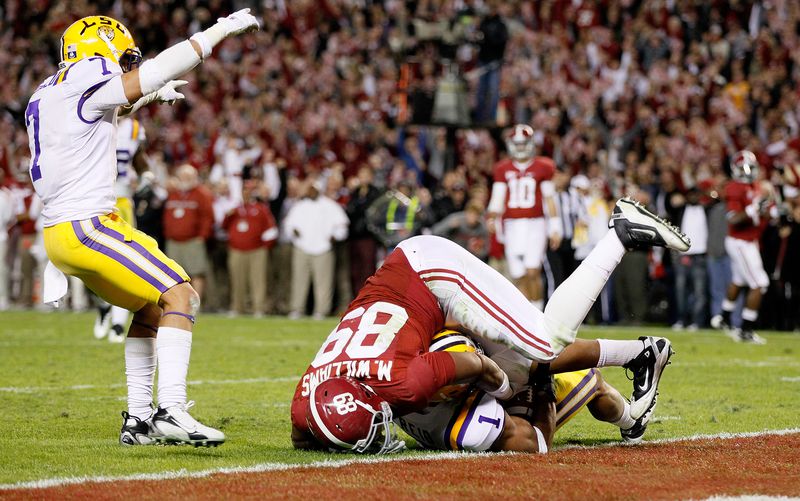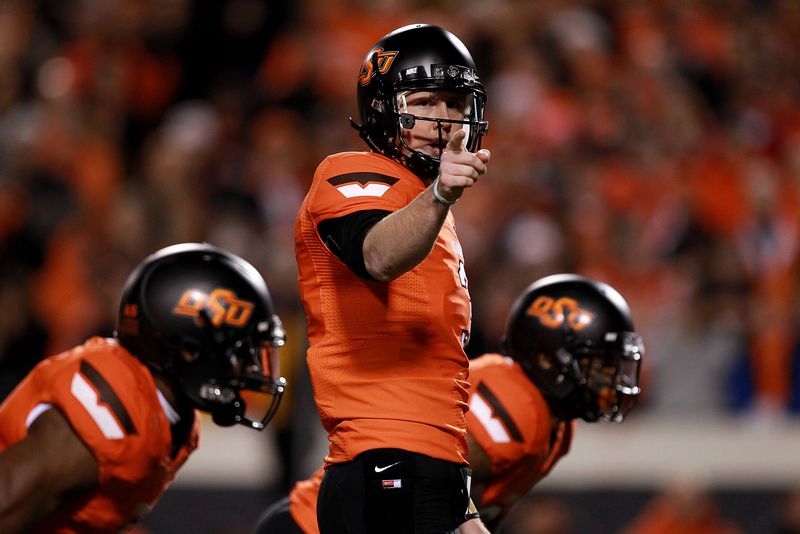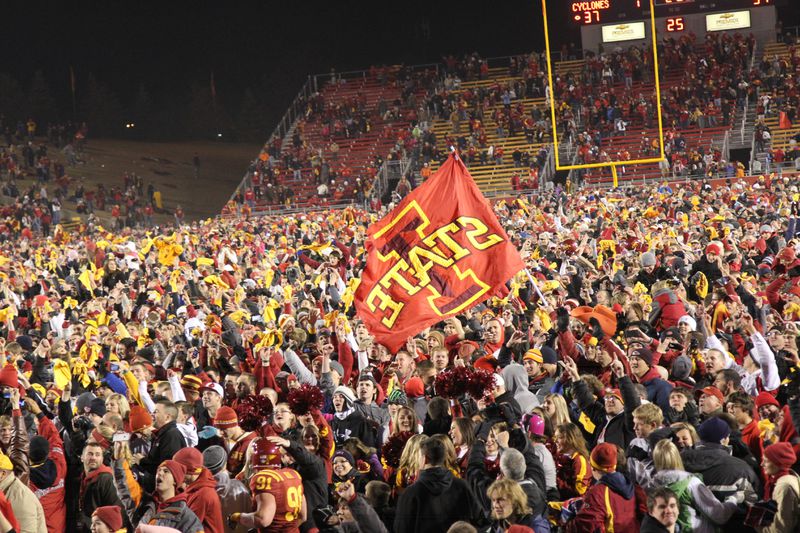mrchase
Member
How 1 play at Iowa State changed Bama-LSU (and all of college football)
0 New, 56 comments
Imagine the alternate reality we’d be living in right now if one moment five years ago in Ames, Iowa had gone the other way.
by Bill Connelly@SBN_BillC Nov 4, 2016, 9:38am EDT tweet
 Photo by Chris Graythen/Getty Images
Photo by Chris Graythen/Getty Images
One line from a 2011 box score:
4-1 ISU 20 Sharp, Quinn field goal attempt from 37 MISSED — wide right, spot at ISU 20, clock 01:17.
Oklahoma State’s Quinn Sharp would make his final five field goals of the season, including one that would win the Fiesta Bowl over Andrew Luck’s Stanford. He would nail 28 of 34 field goals while earning All-American honors the next year. He’s spent time in the pros.
The record says Sharp missed his second attempt of Nov. 18, 2011, and that 10 plays later, Jeff Woody clinched a 37-31 ISU win with a 4-yard plunge in the second overtime.
Sharp kicked a hell of a lot of field goals at Oklahoma State. But if Sharp missed that one, it was by an eyelash. And when Woody crossed the goal line, it sent Ames into pandemonium and set in motion one hell of a butterfly effect.
Between World War II and 2005, Alabama and LSU met five times as top-10 opponents. Since former LSU coach Nick Saban came to Tuscaloosa in 2007, however, they've done it five more times.
Alabama-LSU has become appointment viewing, a Manball Christmas celebration in November. The hits are big and loud, the underdog confounds the favorite (which was even the case in 2007, when national champion LSU barely survived Tuscaloosa) ... and Saban's team usually finds a way. That Saban has lost three times to Les Miles makes Miles one of his greatest tormentors, but Saban has still won more.
-- LSU-Alabama has become the rivalry most likely to define a college football season
When Alabama and LSU kick off on Saturday night in Baton Rouge, it will be five years to the day, damn near to the minute, since maybe the most famous game in the rivalry.
It's the most notorious, anyway.
And it was arguably Miles' crowning achievement.
Heading into 2011, Miles was in need of a big season. He had begun his LSU tenure 34-6, finishing sixth, third, then first in the AP poll. But after starting 4-0 in 2008 and again reaching the top five, the Tigers cratered. They would go just 13-9 through 2009. Florida won the national title in 2008, Alabama in 2009, and Auburn in 2010. It was time for the Tigers to break through again.
LSU responded with maybe the greatest regular season run of all-time. The Tigers began by beating eventual Rose Bowl champion Oregon in Arlington, plowed through No. 25 Mississippi State, and outraced eventual Orange Bowl champion West Virginia, 47-21, in Morgantown.
After trouncing Kentucky, No. 17 Florida, and Tennessee, they rolled defending champ Auburn, 45-10. They beat Western Kentucky and Ole Miss by a combined 94-12, spotted Bobby Petrino's best Arkansas team — one that would win the Cotton Bowl and finish No. 4 in the polls — 14 points before rolling 41-17, then spotted Georgia 10 in the SEC title game before cruising, 42-10.
Among the conquests was the one in Tuscaloosa. College football was becoming lucha libre, and this was sumo, with massive bodies smashing against each other in stalemate. The teams combined for 4.5 yards per play, four turnovers, and zero touchdowns. Alabama moved the ball at will between the 20s but kept missing field goals. Cade Foster missed a 44-yarder and 50-yarder in the first quarter, and Jeremy Shelley had a 49-yarder blocked in the second.
Bama did make two of five, but the missed opportunities haunted them. A Morris Claiborne interception late in the third quarter set Drew Alleman up for a game-tying three-pointer early in the fourth. Then Eric Reid wrestled away another pick on a trick-play pass at the LSU 1. The game went to overtime, where Foster missed a 52-yarder and Alleman nailed one from 25.
LSU 9, Alabama 6
 <img src="https://cdn3.vox-cdn.com/uploads/chorus_asset/file/7403753/136107984.jpg" alt="LSU v Alabama">
<img src="https://cdn3.vox-cdn.com/uploads/chorus_asset/file/7403753/136107984.jpg" alt="LSU v Alabama">
Eric Reid wrestles the ball from Alabama’s Michael Williams
Getty
John Chavis' 2011 LSU defense was absurdly fun to watch, equipped with maybe the most dynamic secondary ever. As I wrote in the upcoming 50 Best* College Football Teams of All-Time:
The college football universe was very offense-friendly in 2011. Eighteen teams averaged at least 35 points per game, and only three allowed fewer than 15. Defenses were still trying to adjust to the matchup advantages the spread offense was able to create.
LSU, however, came up with a pretty ingenious solution: Field one of the most dangerous, aggressive, and downright entertaining defensive backfields in the history of the game. Voila! [Tyrann] Mathieu, Reid, [Brandon] Taylor, Claiborne, [Tharold] Simon, and [Ron] Brooks combined for 16 interceptions, 39 pass breakups, 27 tackles for loss, six sacks, 11 forced fumbles, and 10 fumble recoveries. LSU allowed seven touchdown passes all season; including special teams returns, these six players combined for eight touchdowns of their own.
John Chavis had already spent more than 15 years as a successful defensive coordinator in the SEC, first at Tennessee and then at LSU. This was his masterpiece. Combined with an offense that was both efficient and drastically overshadowed, head coach Les Miles’ Bayou Bengals took down an incredible eight ranked teams (three in the top five) on their way to the BCS Championship game. But they failed the final test.
That final test could have turned out differently.
All it could have taken was for OSU’s Sharp to do what he did in most of 2011: kick a mid-length field goal between the uprights. If he did, and if a last-ditch effort from Paul Rhoads’ Cyclones came up short, the Cowboys would have finished 12-0 and qualified for the BCS title game, preventing a controversial rematch between two SEC West teams.
OSU and Mike Gundy would have lined up opposite Miles, the coach who left Stillwater for Baton Rouge seven years earlier.
That OSU team that could’ve gotten a title shot against LSU was awesome.
The Cowboys ranked first in Off. S&P+, ahead of LaMichael James’ Oregon, Robert Griffin III’s Baylor, and Geno Smith’s West Virginia.
Brandon Weeden threw for 4,727 yards and 37 touchdowns. Joseph Randle and Jeremy Smith rushed for 1,862 yards and 33 scores. The trio of Justin Blackmon, Josh Cooper, and Tracy Moore caught 237 passes for 2,909 yards and 25 trips to the end zone.
Though OSU’s defense wasn't LSU's, it was sturdy. Linemen Jamie Blatnick and Nigel Nicholas combined for 23.5 tackles for loss, three Cowboys recorded at least four interceptions each, and in the pass-happy Big 12, the Cowboys allowed only a 114.7 passer rating and finished second in the nation with 24 picks.
After a torrid comeback in College Station — they trailed Texas A&M 20-3 at halftime before ripping off 27 straight — the Pokes caught fire. They took down eight-win Texas and Missouri teams by a combined 33 on the road. They destroyed Baylor by 35 and survived a shootout against eventual 10-win Kansas State. They humiliated Tommy Tuberville and Texas Tech, 66-6, in Lubbock. And after the ill-fated trip to Ames, they crushed No. 13 Oklahoma, 44-10. Then they finished with the Fiesta Bowl win.
 <img src="https://cdn2.vox-cdn.com/uploads/chorus_asset/file/7406669/134718254.jpg" alt="Oklahoma v Oklahoma State">
<img src="https://cdn2.vox-cdn.com/uploads/chorus_asset/file/7406669/134718254.jpg" alt="Oklahoma v Oklahoma State">
Brandon Weeden was spectacular in 2011
Photo by Ronald Martinez/Getty Images
Oklahoma State was legitimately one of the three best teams in the country. The problem was, they were No. 3.
They were a couple of points behind LSU and Alabama and at least a couple of points ahead of everyone else in the S&P+ team ratings, just as they were in the BCS.
Anything could have happened in an LSU-OSU title game. But odds and matchups would have favored the Tigers.
Either way, college football looks very different in 2016 if OSU had gotten its shot and won it.
For starters, if OSU wins, that gives Gundy as many national titles as OU’s Bob Stoops, which perhaps leads to an LSU-style booster freakout in Norman.
It also means a spread team wins the national title a year after Oregon had nearly done the same. It would have been a strike for democracy, a blow against the ruling class, and it may have ushered in a spread revolution a year or two more quickly than it did. (Here’s your reminder that, five years after the 2011 Bama-LSU matches, Alabama is in no way a sumo wrestler anymore.)
But in the more likely event of an LSU title in 2011, think of what would’ve changed since.
Miles would be a two-time national champion, only one behind Saban, and not even angry LSU boosters could’ve gotten him dumped early in 2016.
Alabama’s dynasty would still mostly be in effect, but Saban wouldn’t have the same air of inevitability.
And that’s before you play out any recruiting scenarios that could’ve tipped in Miles’ favor if you change the 2011 season’s championship, which would’ve meant Miles being able to claim one of college football’s best teams ever.
Oh, and college football maybe doesn’t have a playoff.
Okay, it probably does by this point. By the end of 2011, football’s decision makers had been debating it for a while, and we were all just waiting for a tipping point.
According to many, the 2011 BCS title game was that point. Alabama eked out the No. 2 ranking in the BCS standings by decimal points over Oklahoma State, and ratings for the title game rematch sank. Outrage + fewer viewers = change.
By the following spring, it was clear change was on the way. And by June 2012, the BCS was officially given its death sentence.
A playoff would have come eventually anyway, but it might not have been ready to go by 2014.
No 2014 CFP means no third Urban Meyer national title (actually, a BCS in 2014 probably would have given us a Florida State-Alabama matchup, and Saban might have gotten his extra national title there instead) and no Baylor and TCU getting jumped by Ohio State in the CFP rankings, meaning maybe no 24 months of Big 12 expansion freakouts.
I’m still not sure Sharp missed that field goal, by the way.
In fact, every time I watch it, I become slightly more sure he didn’t. But the box score, the official record, disagrees. It always will.
Saban has made college football, the most unstable element on sport’s periodic table, seem reliable and predictable. And that fits with how we view things — our way of boiling coaches’ résumés down to “he can’t win the big one,” then turning that into “he’ll never win the big one,” has never been rational, and we further lose our rationality when Saban’s team beats ours.
To be sure, there’s a chance that, on Saturday night, Saban and his Crimson Tide will extinguish all hope of an upset, as they have done so many times.
But an LSU-Alabama game should always serve as a reminder of how small the margins are, even for the best coach in college football.
Sometimes only the width of an upright, a trip to Ames, and a man named Jeff Woody are all that separate us from a wild alternate reality.
 <img src="https://cdn2.vox-cdn.com/uploads/chorus_asset/file/7402509/133408809.jpg" alt="Oklahoma State v Iowa State"> Photo by Reese Strickland/Getty Images
<img src="https://cdn2.vox-cdn.com/uploads/chorus_asset/file/7402509/133408809.jpg" alt="Oklahoma State v Iowa State"> Photo by Reese Strickland/Getty Images
0 New, 56 comments
Imagine the alternate reality we’d be living in right now if one moment five years ago in Ames, Iowa had gone the other way.
by Bill Connelly@SBN_BillC Nov 4, 2016, 9:38am EDT tweet

One line from a 2011 box score:
4-1 ISU 20 Sharp, Quinn field goal attempt from 37 MISSED — wide right, spot at ISU 20, clock 01:17.
Oklahoma State’s Quinn Sharp would make his final five field goals of the season, including one that would win the Fiesta Bowl over Andrew Luck’s Stanford. He would nail 28 of 34 field goals while earning All-American honors the next year. He’s spent time in the pros.
The record says Sharp missed his second attempt of Nov. 18, 2011, and that 10 plays later, Jeff Woody clinched a 37-31 ISU win with a 4-yard plunge in the second overtime.
Sharp kicked a hell of a lot of field goals at Oklahoma State. But if Sharp missed that one, it was by an eyelash. And when Woody crossed the goal line, it sent Ames into pandemonium and set in motion one hell of a butterfly effect.
Between World War II and 2005, Alabama and LSU met five times as top-10 opponents. Since former LSU coach Nick Saban came to Tuscaloosa in 2007, however, they've done it five more times.
Alabama-LSU has become appointment viewing, a Manball Christmas celebration in November. The hits are big and loud, the underdog confounds the favorite (which was even the case in 2007, when national champion LSU barely survived Tuscaloosa) ... and Saban's team usually finds a way. That Saban has lost three times to Les Miles makes Miles one of his greatest tormentors, but Saban has still won more.
-- LSU-Alabama has become the rivalry most likely to define a college football season
When Alabama and LSU kick off on Saturday night in Baton Rouge, it will be five years to the day, damn near to the minute, since maybe the most famous game in the rivalry.
It's the most notorious, anyway.
And it was arguably Miles' crowning achievement.
Heading into 2011, Miles was in need of a big season. He had begun his LSU tenure 34-6, finishing sixth, third, then first in the AP poll. But after starting 4-0 in 2008 and again reaching the top five, the Tigers cratered. They would go just 13-9 through 2009. Florida won the national title in 2008, Alabama in 2009, and Auburn in 2010. It was time for the Tigers to break through again.
LSU responded with maybe the greatest regular season run of all-time. The Tigers began by beating eventual Rose Bowl champion Oregon in Arlington, plowed through No. 25 Mississippi State, and outraced eventual Orange Bowl champion West Virginia, 47-21, in Morgantown.
After trouncing Kentucky, No. 17 Florida, and Tennessee, they rolled defending champ Auburn, 45-10. They beat Western Kentucky and Ole Miss by a combined 94-12, spotted Bobby Petrino's best Arkansas team — one that would win the Cotton Bowl and finish No. 4 in the polls — 14 points before rolling 41-17, then spotted Georgia 10 in the SEC title game before cruising, 42-10.
Among the conquests was the one in Tuscaloosa. College football was becoming lucha libre, and this was sumo, with massive bodies smashing against each other in stalemate. The teams combined for 4.5 yards per play, four turnovers, and zero touchdowns. Alabama moved the ball at will between the 20s but kept missing field goals. Cade Foster missed a 44-yarder and 50-yarder in the first quarter, and Jeremy Shelley had a 49-yarder blocked in the second.
Bama did make two of five, but the missed opportunities haunted them. A Morris Claiborne interception late in the third quarter set Drew Alleman up for a game-tying three-pointer early in the fourth. Then Eric Reid wrestled away another pick on a trick-play pass at the LSU 1. The game went to overtime, where Foster missed a 52-yarder and Alleman nailed one from 25.
LSU 9, Alabama 6

Eric Reid wrestles the ball from Alabama’s Michael Williams
Getty
John Chavis' 2011 LSU defense was absurdly fun to watch, equipped with maybe the most dynamic secondary ever. As I wrote in the upcoming 50 Best* College Football Teams of All-Time:
The college football universe was very offense-friendly in 2011. Eighteen teams averaged at least 35 points per game, and only three allowed fewer than 15. Defenses were still trying to adjust to the matchup advantages the spread offense was able to create.
LSU, however, came up with a pretty ingenious solution: Field one of the most dangerous, aggressive, and downright entertaining defensive backfields in the history of the game. Voila! [Tyrann] Mathieu, Reid, [Brandon] Taylor, Claiborne, [Tharold] Simon, and [Ron] Brooks combined for 16 interceptions, 39 pass breakups, 27 tackles for loss, six sacks, 11 forced fumbles, and 10 fumble recoveries. LSU allowed seven touchdown passes all season; including special teams returns, these six players combined for eight touchdowns of their own.
John Chavis had already spent more than 15 years as a successful defensive coordinator in the SEC, first at Tennessee and then at LSU. This was his masterpiece. Combined with an offense that was both efficient and drastically overshadowed, head coach Les Miles’ Bayou Bengals took down an incredible eight ranked teams (three in the top five) on their way to the BCS Championship game. But they failed the final test.
That final test could have turned out differently.
All it could have taken was for OSU’s Sharp to do what he did in most of 2011: kick a mid-length field goal between the uprights. If he did, and if a last-ditch effort from Paul Rhoads’ Cyclones came up short, the Cowboys would have finished 12-0 and qualified for the BCS title game, preventing a controversial rematch between two SEC West teams.
OSU and Mike Gundy would have lined up opposite Miles, the coach who left Stillwater for Baton Rouge seven years earlier.
That OSU team that could’ve gotten a title shot against LSU was awesome.
The Cowboys ranked first in Off. S&P+, ahead of LaMichael James’ Oregon, Robert Griffin III’s Baylor, and Geno Smith’s West Virginia.
Brandon Weeden threw for 4,727 yards and 37 touchdowns. Joseph Randle and Jeremy Smith rushed for 1,862 yards and 33 scores. The trio of Justin Blackmon, Josh Cooper, and Tracy Moore caught 237 passes for 2,909 yards and 25 trips to the end zone.
Though OSU’s defense wasn't LSU's, it was sturdy. Linemen Jamie Blatnick and Nigel Nicholas combined for 23.5 tackles for loss, three Cowboys recorded at least four interceptions each, and in the pass-happy Big 12, the Cowboys allowed only a 114.7 passer rating and finished second in the nation with 24 picks.
After a torrid comeback in College Station — they trailed Texas A&M 20-3 at halftime before ripping off 27 straight — the Pokes caught fire. They took down eight-win Texas and Missouri teams by a combined 33 on the road. They destroyed Baylor by 35 and survived a shootout against eventual 10-win Kansas State. They humiliated Tommy Tuberville and Texas Tech, 66-6, in Lubbock. And after the ill-fated trip to Ames, they crushed No. 13 Oklahoma, 44-10. Then they finished with the Fiesta Bowl win.

Brandon Weeden was spectacular in 2011
Photo by Ronald Martinez/Getty Images
Oklahoma State was legitimately one of the three best teams in the country. The problem was, they were No. 3.
They were a couple of points behind LSU and Alabama and at least a couple of points ahead of everyone else in the S&P+ team ratings, just as they were in the BCS.
Anything could have happened in an LSU-OSU title game. But odds and matchups would have favored the Tigers.
Either way, college football looks very different in 2016 if OSU had gotten its shot and won it.
For starters, if OSU wins, that gives Gundy as many national titles as OU’s Bob Stoops, which perhaps leads to an LSU-style booster freakout in Norman.
It also means a spread team wins the national title a year after Oregon had nearly done the same. It would have been a strike for democracy, a blow against the ruling class, and it may have ushered in a spread revolution a year or two more quickly than it did. (Here’s your reminder that, five years after the 2011 Bama-LSU matches, Alabama is in no way a sumo wrestler anymore.)
But in the more likely event of an LSU title in 2011, think of what would’ve changed since.
Miles would be a two-time national champion, only one behind Saban, and not even angry LSU boosters could’ve gotten him dumped early in 2016.
Alabama’s dynasty would still mostly be in effect, but Saban wouldn’t have the same air of inevitability.
And that’s before you play out any recruiting scenarios that could’ve tipped in Miles’ favor if you change the 2011 season’s championship, which would’ve meant Miles being able to claim one of college football’s best teams ever.
Oh, and college football maybe doesn’t have a playoff.
Okay, it probably does by this point. By the end of 2011, football’s decision makers had been debating it for a while, and we were all just waiting for a tipping point.
According to many, the 2011 BCS title game was that point. Alabama eked out the No. 2 ranking in the BCS standings by decimal points over Oklahoma State, and ratings for the title game rematch sank. Outrage + fewer viewers = change.
By the following spring, it was clear change was on the way. And by June 2012, the BCS was officially given its death sentence.
A playoff would have come eventually anyway, but it might not have been ready to go by 2014.
No 2014 CFP means no third Urban Meyer national title (actually, a BCS in 2014 probably would have given us a Florida State-Alabama matchup, and Saban might have gotten his extra national title there instead) and no Baylor and TCU getting jumped by Ohio State in the CFP rankings, meaning maybe no 24 months of Big 12 expansion freakouts.
I’m still not sure Sharp missed that field goal, by the way.
In fact, every time I watch it, I become slightly more sure he didn’t. But the box score, the official record, disagrees. It always will.
Saban has made college football, the most unstable element on sport’s periodic table, seem reliable and predictable. And that fits with how we view things — our way of boiling coaches’ résumés down to “he can’t win the big one,” then turning that into “he’ll never win the big one,” has never been rational, and we further lose our rationality when Saban’s team beats ours.
To be sure, there’s a chance that, on Saturday night, Saban and his Crimson Tide will extinguish all hope of an upset, as they have done so many times.
But an LSU-Alabama game should always serve as a reminder of how small the margins are, even for the best coach in college football.
Sometimes only the width of an upright, a trip to Ames, and a man named Jeff Woody are all that separate us from a wild alternate reality.

